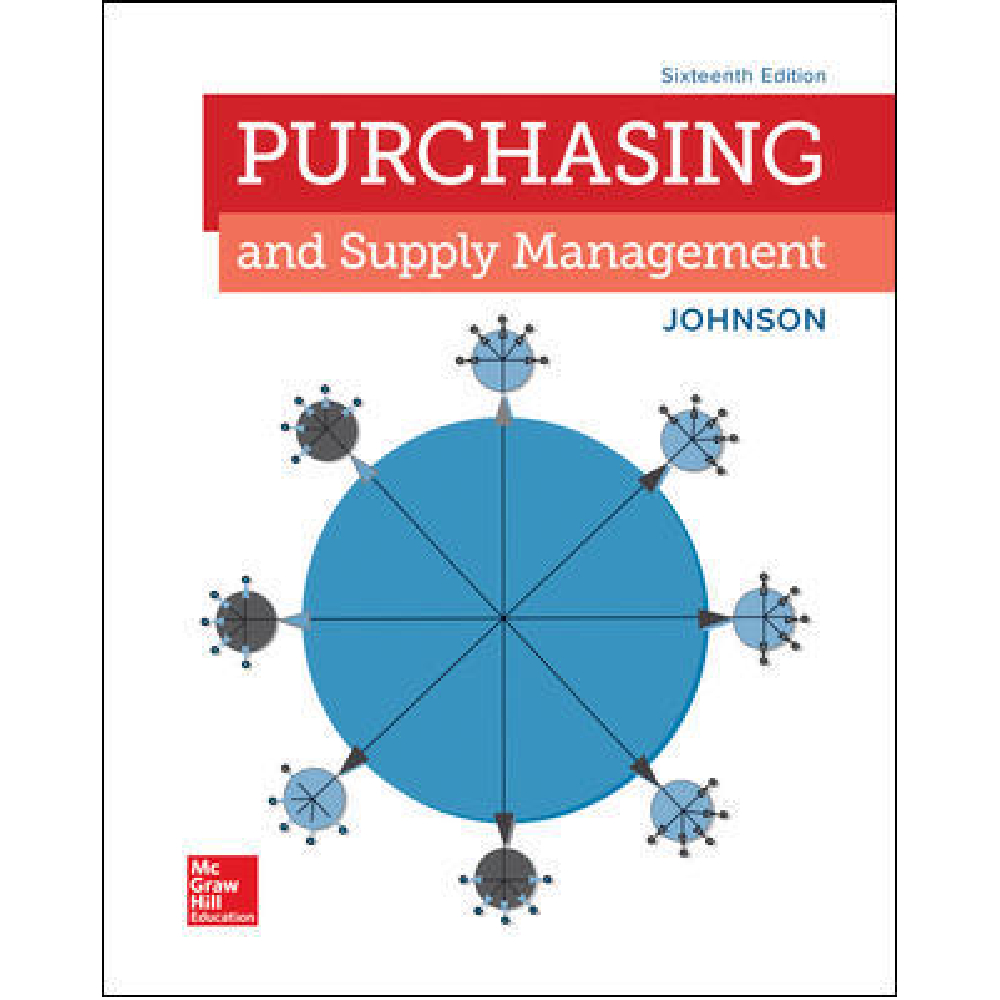Purchasing And Supply Management 16th Edition By P. Fraser Johnson – Test Bank
$55.00
Purchasing And Supply Management 16th Edition By P. Fraser Johnson – Test Bank
You will receive this product within 24 hours after placing the order
Overview
Chapter 11
Cost Management
1) When estimating the cost structure of a manufacturing supplier:
A) material costs are difficult to estimate.
B) direct labor costs are the easiest costs to estimate.
C) prices of raw materials are not commonly accessible.
D) labor rates are typically uniform across different plant locations.
E) equipment depreciation is typically the largest cost element in overhead.
Answer: E
Difficulty: 2 Medium
Topic: Cost management tools and techniques
Bloom’s: Remember
AACSB: Reflective Thinking
Accessibility: Keyboard Navigation
Gradable: automatic
2) After identifying and implementing supply cost savings, the supply manager should:
A) validate the savings with finance/accounting.
B) evaluate potential implications for changes to the budget.
C) notify the budget holder so he or she can use the savings for other expenses or projects.
D) validate the savings with finance/accounting and evaluate potential implications for changes to the budget.
E) validate the savings with finance/accounting, evaluate potential implications for changes to the budget and notify the budget holder so he or she can use the savings for other expenses or projects.
Answer: D
Difficulty: 2 Medium
Topic: Strategic cost management
Bloom’s: Remember
AACSB: Reflective Thinking
Accessibility: Keyboard Navigation
Gradable: automatic
3) The goal of value engineering and value analysis is to:
A) perform a function at the same or an improved level while reducing costs.
B) analyze the value-added from engineering services and production.
C) analyze functions to satisfy all needed quality requirements at any cost.
D) define value of a function in technically accurate and precise language.
E) perform a function at an improved level at the same cost.
Answer: A
Difficulty: 2 Medium
Topic: Cost management tools and techniques
Bloom’s: Understand
AACSB: Reflective Thinking
Accessibility: Keyboard Navigation
Gradable: automatic
4) Portfolio analysis is:
A) a method of multiple sourcing.
B) a method of identifying substitute materials.
C) the categorization of spend map based on the risks to acquire in the marketplace and value.
D) a method of multiple sourcing and the categorization of spend map based on the risks to acquire in the marketplace and value.
E) a method of multiple sourcing, a method of identifying substitute materials and the categorization of spend map based on the risks to acquire in the marketplace and value.
Answer: C
Difficulty: 1 Easy
Topic: Frameworks for cost management
Bloom’s: Understand
AACSB: Reflective Thinking
Accessibility: Keyboard Navigation
Gradable: automatic
5) When cost analysis is applied to a supplier’s price, the buyer:
A) identifies a cost reduction target with no insight into specific cost elements.
B) relies on supplier information about areas where it can cut costs.
C) recognizes that little cost data is available for most cost elements.
D) identifies and analyzes each cost element for cost reduction opportunities.
E) cannot expect any assistance from the supplier.
Answer: D
Difficulty: 2 Medium
Topic: Strategic cost management
Bloom’s: Understand
AACSB: Reflective Thinking
Accessibility: Keyboard Navigation
Gradable: automatic
6) Cost management for services:
A) is confined to internal demand analysis and consumption management.
B) is confined to supplier cost structure analysis.
C) includes demand management and supplier cost structure analysis.
D) focuses primarily on better design of the service.
E) is only possible when the service is highly tangible.
Answer: C
Difficulty: 3 Hard
Topic: Cost management tools and techniques
Bloom’s: Understand
AACSB: Reflective Thinking
Accessibility: Keyboard Navigation
Gradable: automatic
7) Cost management tools and techniques that may provide data for negotiations with internal organizational stakeholders and/or externally with suppliers include:
A) activity-based costing.
B) the learning curve.
C) total cost of ownership.
D) activity-based costing and total cost of ownership.
E) activity-based costing, the learning curve and total cost of ownership.
Answer: E
Difficulty: 3 Hard
Topic: Negotiation
Bloom’s: Understand
AACSB: Reflective Thinking
Accessibility: Keyboard Navigation
Gradable: automatic
8) Purchases categorized as leverage items in portfolio analysis have the following characteristic(s):
A) standard specification or commodity-type items.
B) switching suppliers is difficult.
C) supplier technology is important.
D) standard specification or commodity-type items and supplier technology is important.
E) standard specification or commodity-type items, switching suppliers is difficult and supplier technology is important.
Answer: A
Difficulty: 1 Easy
Topic: Strategic cost management
Bloom’s: Remember
AACSB: Reflective Thinking
Accessibility: Keyboard Navigation
Gradable: automatic
9) A purchasing approach to minimize the acquisition costs and rely on competition to keep prices low is best suited for:
A) bottleneck items.
B) strategic items.
C) leverage/commodity items.
D) noncritical/routine items.
E) bottleneck items and strategic items.
Answer: D
Difficulty: 1 Easy
Topic: Strategic cost management
Bloom’s: Remember
AACSB: Reflective Thinking
Accessibility: Keyboard Navigation
Gradable: automatic
10) In portfolio analysis, cost analysis can be used in the acquisition of strategic goods or services to identify opportunities to:
A) divide the spend for the item or service among multiple suppliers.
B) avoid, eliminate or reduce costs in supplier switching costs.
C) avoid, eliminate or reduce costs in buyer and supplier cost structures.
D) avoid, eliminate or reduce costs in the supplier’s cost structure.
E) avoid, eliminate or reduce costs in the buyer’s cost structure.
Answer: C
Difficulty: 2 Medium
Topic: Strategic cost management
Bloom’s: Understand
AACSB: Reflective Thinking
Accessibility: Keyboard Navigation
Gradable: automatic











Reviews
There are no reviews yet.